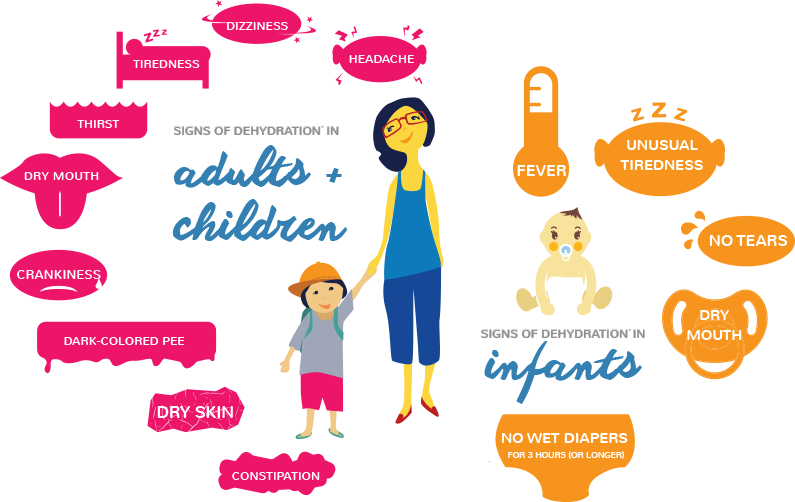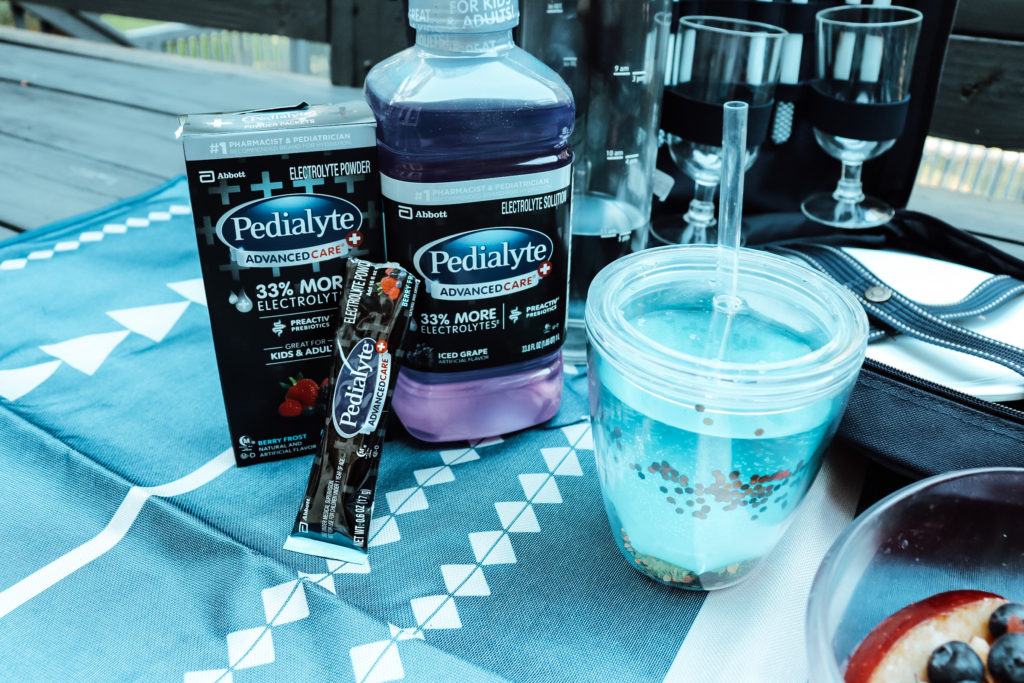This shop has been compensated by Inmar Intelligence and its advertiser. All opinions are mine alone. #PedialyteAtPublix
Why hydration is important, what are electrolytes, and how to stay hydrated during the summer months — all things we will be covering in today’s post!
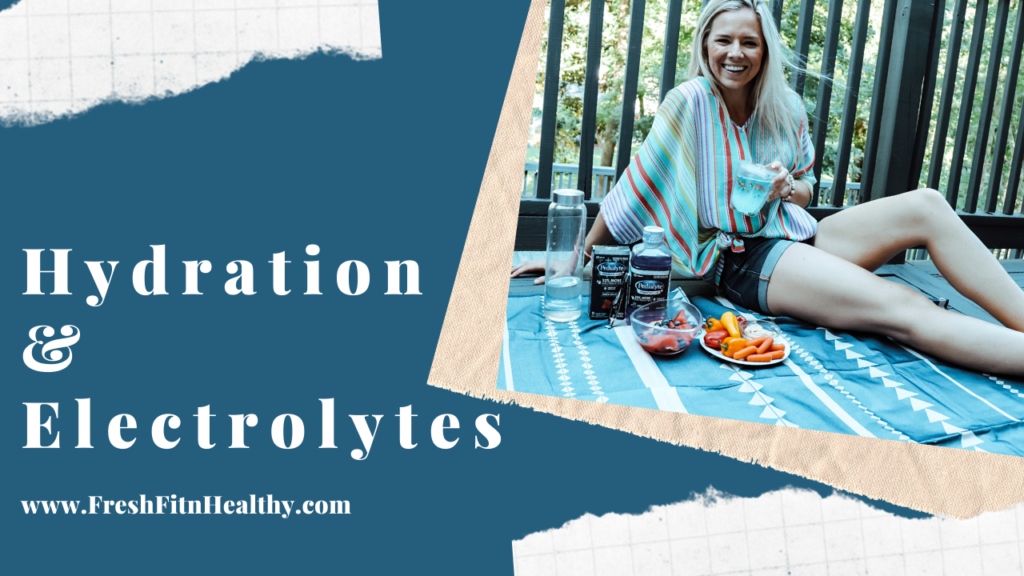
As a dietitian, I am so excited to partner with Pedialyte to share about a very important topic as we head into the hot months —hydration and electrolytes! See, most may think to use Pedialyte during the stomach flu, but it’s become a staple to keep a Pedialyte AdvancedCare Plus® Liter in our fridge and the Powder Packs on me at all times, as it can be great for replenishing electrolytes after a serious workout, during hot, long days on the beach, and more.
So, let’s break hydration and electrolytes down, since we hear these two words in the healthy living space a lot!
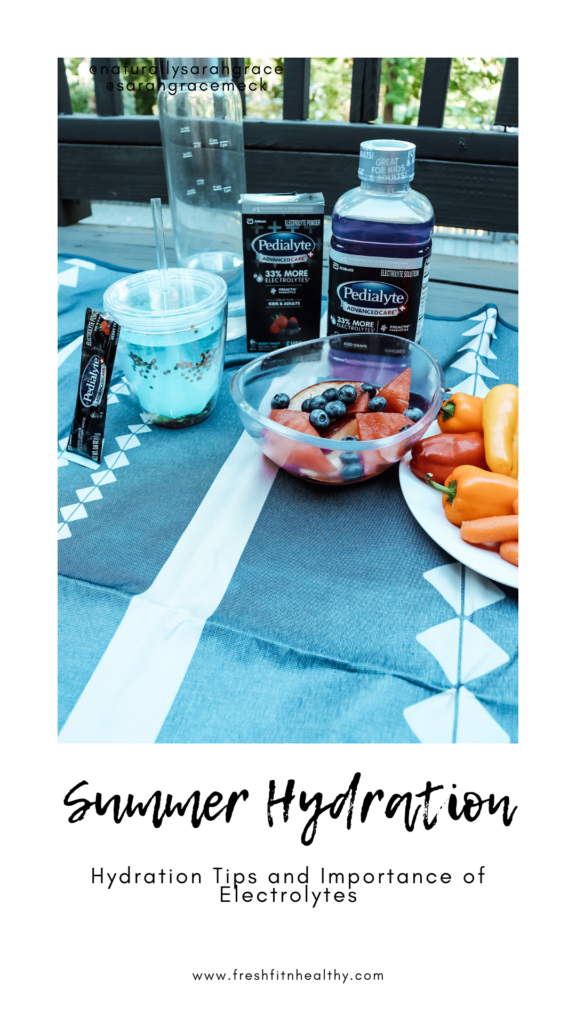
Why is hydration important?!
Well, simply said, our bodies depend on water to survive! Every cell, tissue, and organ in your body needs water to work properly. For example, your body uses water to maintain its temperature, remove waste, and lubricate your joints. So, as you can see, water and staying hydrated is crucial for overall good health!
SIGNS OF DEHYDRATION
Now, you’ll hear, “drink 8 cups of water a day!”. Even though that’s a good generalized rule of thumb, everyone is DIFFERENT. So, I always say that even though that’s a good starting place, the best indicator is the color of your PEE! If it’s clear or super light yellow, you’re good to go. Medium, moderate dehydration. And dark, you’re very dehydrated. Also, if you “feel thirsty,” you’ve probably already waited too long. 🙂
Signs to look out for:
- Little or no urine.
- Urine that is darker than usual.
- Dry mouth.
- Sleepiness or fatigue.
- Extreme thirst.
- Headache.
- Confusion.
- Dizziness or lightheadedness.
- No tears when crying.
So now let’s chat ELECTROLYTES:
What are electrolytes?
Electrolytes are minerals that have an electrical charge to them—cool right!?! Electrolytes include: sodium, bicarbonate, chloride, potassium, calcium, phosphate, and magnesium.
These specific minerals are extremely important to maintaining homeostasis—balance—within our body. Without electrolytes, we would really be in trouble.
See, electrolytes are minerals essential to your health. They help carry electrical signals that power your nerves and muscles, maintain your blood’s proper pH, and balance fluids in your body. You get electrolytes from what you eat and drink, and you lose them any time you lose fluids (like when you sweat or go to the bathroom).
Electrolyte balance:
Electrolyte balance is very much about our body’s fluid balance. Thus, the most common reasons for electrolyte imbalances are those that involve dehydration.
Here are some of the more common reasons:
- Stomach Flu
- Food Poisoning
- Travel
- Heat
- Exercise
Signs of electrolyte imbalance:
- Arrhythmia (irregular heart beat)
- Bradycardia (slow heart rate)
- Confusion
- Diarrhea/Constipation
- Fatigue/Weakness
- Headaches
- Hypotension (low blood pressure)
- Irritability
- Muscle Cramps
- Muscle Weakness
- Nausea/Vomiting
- Numbness/Tingling
- Seizures
- Syncope (fainting/loss of consciousness)
- Tachycardia (fast heart rate)
- Twitching
(If you experience these symptoms, it is important to consult with a health professional so you can be treated properly and avoid long-term health consequences.)
So now that we see just how important hydration and electrolytes are, let me share 5 ways to increase electrolytes in your diet!
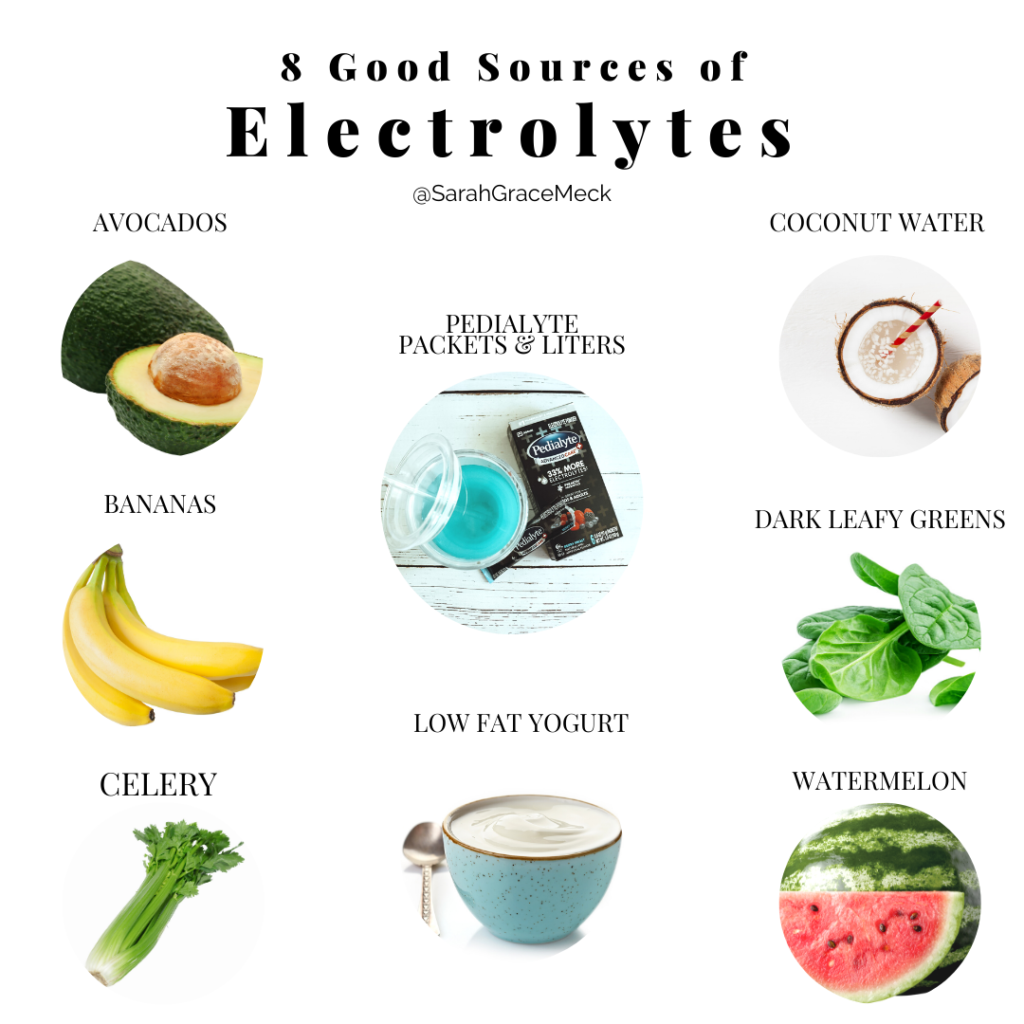
5 TIPS TO GET MORE ELECTROLYTES IN YOUR DAILY LIFE
1) Use Pedialyte for more than just sickness!
- Whereas sports drinks have a ton more sugar than electrolytes, Pedialyte contains an optimal balance of electrolytes and carbohydrates for fast rehydration. They’re not only the #1 pediatrician recommended oral electrolyte solution brand and the #1 pharmacist recommended brand for hydration, they’re also a super convenient way to replenish your fluids and electrolytes the right way!
- Most people think of using this only when they have a stomach bug, but my husband and I keep the Pedialyte Powder Packs on us for anything like after intense workouts, long beach/boat days in the sun, and hikes during vacation!
- Two Pedialyte products I’ve loved finding at my local Publix:
- Pedialyte AdvancedCare Plus Powder Packs & Liters
- Formulated for higher electrolyte loss
- PreActiv Prebiotics to help promote digestive health
- Designed to prevent mild to moderate dehydration more effectively than household beverages, like sports drinks, juice, and soda
- Great for kids and adults!
- Packets:
- Convenient for on-the-go
- Quickly replaces fluids and electrolytes
- Liters:
- Also includes zinc for immune support, and replaces electrolytes and fluids!
- Pedialyte AdvancedCare Plus Powder Packs & Liters
- PS: you can get 25% off any Pedialyte product at Publix from 7/23 to 7/29! Pedialyte products can be found in either the baby aisle or the digestive care section of Publix stores. Check out this deal here! #PedialyteAtPublix
2) Keep a reusable water bottle on you
- This may sound silly, but the easiest way to stay hydrated is to have a bottle in sight at all times — as that will help you think to drink!
- During travel, bring a refillable bottle with you. During workouts, hikes, and boat days, don’t forget to pack some water. And, when it’s really hot out there, pour a Pedialyte packet in!
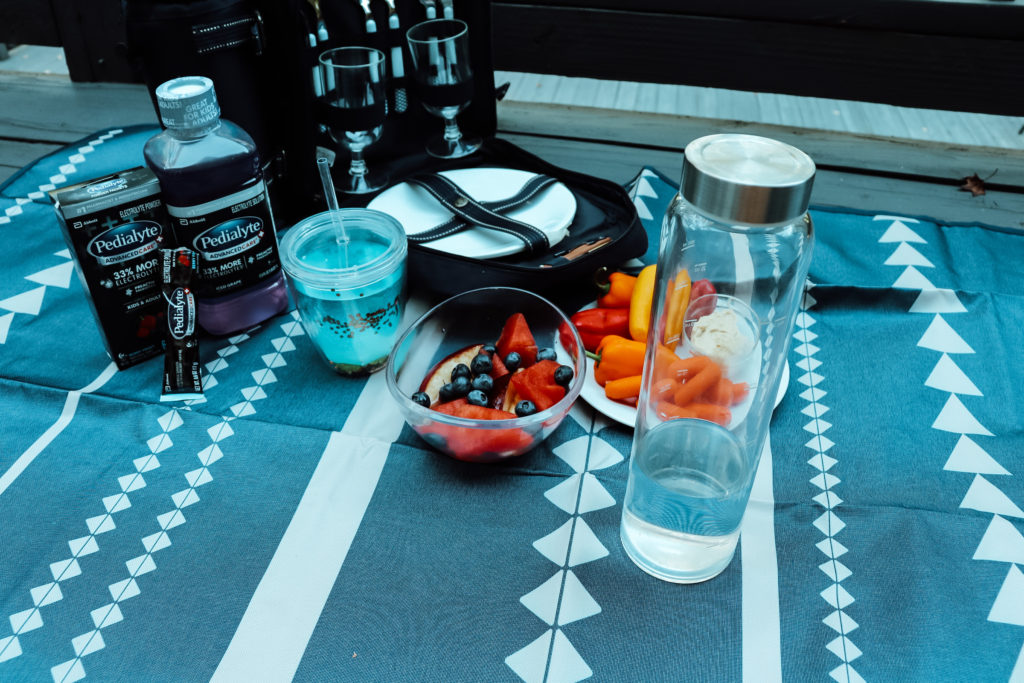
3) Infuse your water
- I LOVE putting fresh/frozen fruit, basil/mint leaves, or vitality essential oils in my water! Ex: using frozen strawberries in my water acts as both ice AND flavor to the water!
- You can make combinations:
- Strawberries and basil leaves
- Lemon juice and a little stevia for a “light lemonade”
- Cucumbers and orange slices
- Blueberries and mint
- Any vitality essential oil such as grapefruit, lemon, or orange
4) Eat foods with high water content:
- Not only liquids have water in them, but some foods do too!
- Try to add some watermelon, cucumbers, lettuce, melons, grapefruit, oranges, pineapple, celery, and berries to your daily diet.
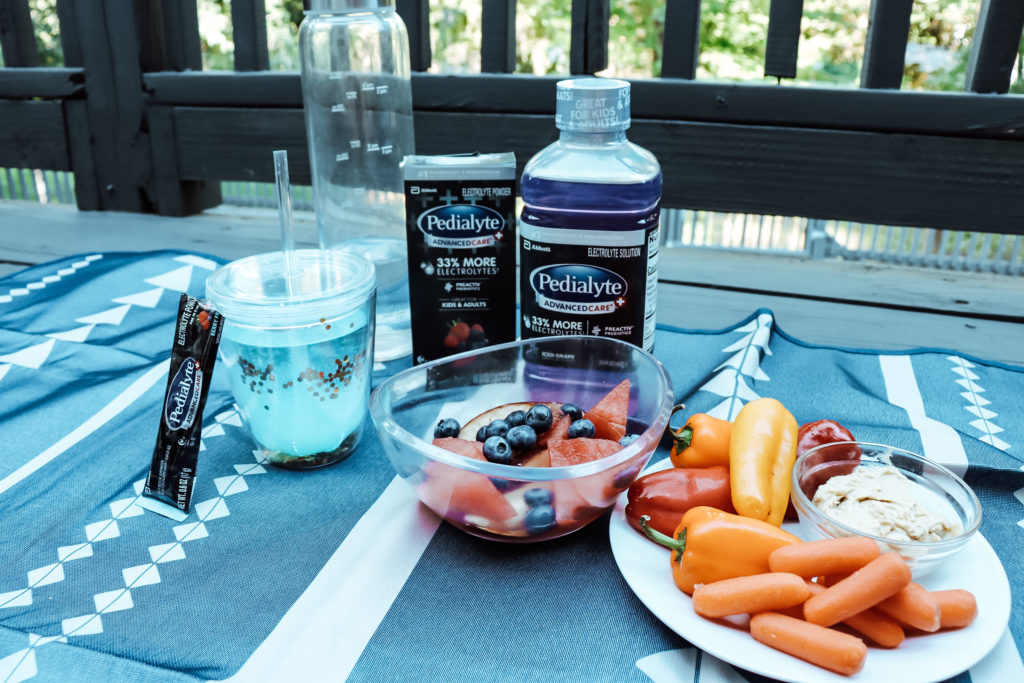
5) Eat foods with high electrolyte content:
- Sodium: fermented foods, breads with added sodium, and celery, carrots, spinach, chard, and beets all naturally contain sodium.
- Chloride (not one to usually be deficient in except in extreme circumstance): Most of the chloride consumed by humans is associated with the consumption of salt—mostly through sodium chloride. But it can be found in trace amounts within celery, eggs, fresh meats, kelp (seaweed), lettuce, olives, rye, seafood, and tomatoes
- Potassium: ½ cup dried apricots (23% DV), 6oz wild-caught salmon (23% DV), 1 avocado (21% DV), baked potato (20% DV), 1 cup lentils, Cooked (16% DV), ½ cup prunes (15% DV), 1 cup kiwi (12% DV), 1 cup cantaloupe (10% DV)
- Phosphate: 6oz chicken breast, roasted, 30% DV, 3oz wild salmon, 21% DV, 6oz plain yogurt, 20% DV, 1 cup brown rice, 16% DV, ½ cup lentils, cooked, 14% DV, 3oz beef patty, 90% lean, 14% DV, potato w/skin, 10% DV, ½ cup kidney beans, 9% DV
- Magnesium: 1 cup brown rice, 20% DV, 1oz almonds, 19% DV, 1oz cashews, 18% DV, ½ cup black beans, 14% DV, ½ cup edamame, shelled, 12% DV, 2 tbsp peanut butter, 12% DV, 6oz wild salmon, 12% DV, potato w/skin, 10% DV, 8oz plain yogurt, 10% DV, 6oz chicken breast, roasted, 10% DV
Did you learn something from this? Which of the 5 tips will you be taking away? Let me know on my newest Instagram post right here!
Other Similar Posts?
